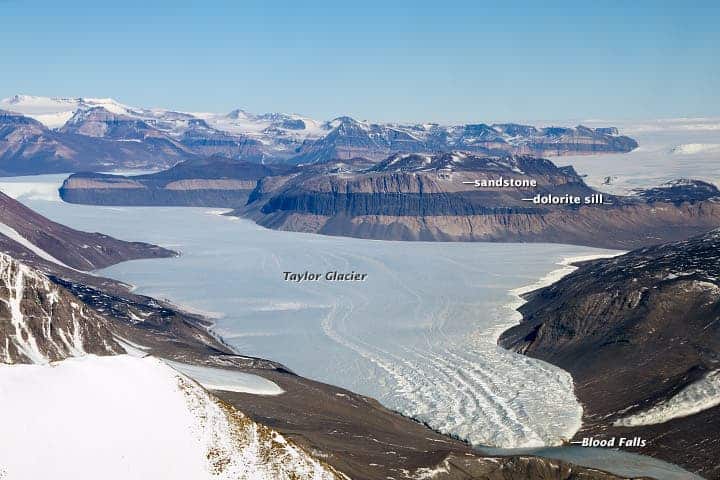If you’ve ever visited the McMurdo Dry Valleys in Antarctica, then you’ve likely had a surprise. The cold, frigid white background cut by snowless valleys is marked by the Onyx river, the continent’s longest and largest river, which ends with a five-storey-tall waterfall that spills bright blood-red water over an enormous glacier.

What’s a blood-red waterfall doing in Antarctica, one might ask ?! Well, the water that reaches the waterfall is salty in the first place – the source of the saltwater is a pool of unknown size located several kilometers before the blood waterfall and overlain by about 400 metres (1,300 ft) of ice. Australian geologist Griffith Taylor, who first explored the valley and discovered the river, first thought that the red color is caused by algae, but his theory was proven wrong. Today, we know that the source of the red is actually iron. But let’s start from the beginning, shall we? Everything started around 5 million years ago…
The world was slowly warming, and water levels were rising throughout the planet. As the seas started to flood Antarctica, a salty lake formed in the area – our river from above. The river was covered by a thick sheet of ice and snow, isolating it from the rest of the world and covering it with what became a huge glacier. At this point, the lake is incredibly salty. The river also scraped the top of the rock layer it was sitting on, eroding and integrating its iron. So whenever the salty lake seeps through a fissure in the glacier, the waters make contact with oxygen for the first time in millions of years and instantly oxidize (rust), leaving a blood-red stain on the pristine glacier. All fine and good here, but the thing is that it’s exactly this reason why researchers can’t study it – because the moment it makes contact with air, it starts to change.

So Jill Mikucki, a microbiologist from the University of Tennessee Knoxville in the US, came up with a solution, as described at The Antarctic Sun, published by the US Antarctica Program:
“The IceMole is a long rectangular metal box with a copper head and ice screw at one end capable of melting its way through ice – but not just straight down like a conventional electro-thermal drill. Differential heating at the tip allows IceMole to change directions. It looks a bit like a very large hypodermic needle poised to inoculate a glacier.
‘It can drive curved trajectories through bulk ice. It can go sideways, up and down. If you want to reach any point, you can go there,’ explained Dirk Heinen, a German physicist, while troubleshooting the first attempt to send the IceMole into Taylor Glacier that ended shortly after it began.”

IceMole is an autonomous ice research probe, incorporating a new type of ice-melting tip for the exploration of polar regions, glaciers, ice sheets, and extraterrestrial regions, developed by a team from the FH Aachen, a Fachhochschule (University of Applied Sciences) in Aachen, Germany. The advantage of this technology is that it can change its direction and be recovered after use.

Using IceMole, Mikucki’s team has managed to extract the first ever samples from the blood falls lake, which will finally give them the chance to study the incredible microbes that can live in complete and utter darkness, devoid of oxygen, and with enough salt to kill any of us.
“It offers us a portal, or window, to the subglacial world … a sample of material from that ice-covered interior,” Mikucki told The Antarctic Sun. “It tells us what might be living below the ice of the continent. There are no large animals or trees on Antarctica anymore. It’s a microbial continent.”






